Dbrady3702
English teacher, reading teacher, writing center director, assistant superintendent, adjunct instructor, my life in edcuation.
Coteaching
Best teaching practices. Teaching and Learning. 18 Teacher-Tested Strategies for Differentiated Instruction. Posted 12/05/2014 2:22PM | Last Commented 12/13/2014 10:03AM.
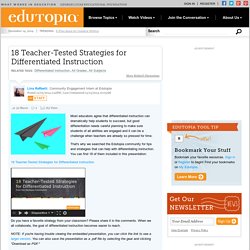
Data Team. CC PART 1 Where to start. PARCC Assessments. More PARCC. MATH CC resources. Writing to Text. Download YouTube videos on iPad [BEST WAY]
UBD. Technology and Education. Ipad and ELA. Establishing the PLC - Professional Learning Communities. Making Mastery Work. Resources.

Pump Students Up with Digital Icebreakers. 197 Educational YouTube Channels You Should Know About. 197 Educational YouTube Channels You Should Know About If you don’t have a YouTube channel as an education provider, there’s a good chance you’re behind the times.
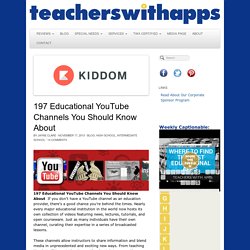
Nearly every major educational institution in the world now hosts its own collection of videos featuring news, lectures, tutorials, and open courseware. Just as many individuals have their own channel, curating their expertise in a series of broadcasted lessons. These channels allow instructors to share information and blend media in unprecedented and exciting new ways.
The Daily Scholar: Writing Lessons - Robert Hahn. Guskey_2013_The-Case-Against-Percentage-Grades.pdf. Education Week. Quick & Easy Formative Assessments UPDATED. 6 Factors Of Academic Performance. A Classroom Of Proficiency: 6 Factors To Guide Your Teaching by Terry Heick First, a definition.
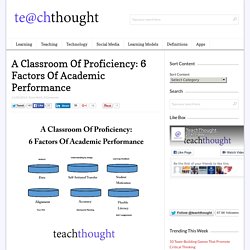
An academic classroom is one where the primary goal is to promote proficiency of academic standards. Everything else, while appreciated and winked at, comes after.
Five-Minute Film Festival: Developing Global Citizens. In our increasingly connected and interdependent world, it’s critically important that young people have opportunities to engage with diverse cultural perspectives, build geographic knowledge, grow global competency, and develop the skills and knowledge necessary to consider and address our shared global challenges.

At Global Education Day in Atlanta this year, I was inspired by all the ways that educators are bringing these kinds of experiences into the classroom. How do you teach global citizenship?
Educational Leadership:Instruction That Sticks:A Practice That Works in Your Classroom. —Timothy Dohrer, director, teacher preparation, Northwestern University, Evanston, Illinois Seamless Differentiation In my math classes, I use a collaborative strategy called trail run.
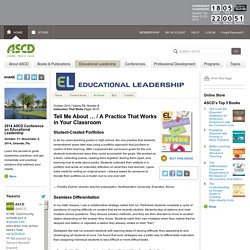
Partnered students complete a cycle of questions of varying difficulty on content that we've recently studied. Students stop at stations and read multiple-choice questions.
Dyslexia in the General Education Classroom. The following passage is about dyslexia.
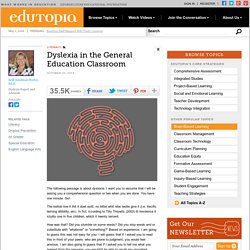
I want you to assume that I will be asking you a comprehension question or two when you are done. You have one minute. Go! The bottob line it thit it doet exitt, no bitter whit nibe teotle give it (i.e. ttecific leirning ditibility, etc).
Engaging English Language Learners in Academic Conversations. In this new series, created in partnership with Oakland Unified School District, we delve into three classrooms where English Language Learners (ELLs) are engaged in academic conversations.
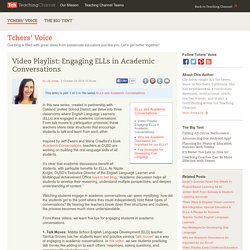
From talk moves to participation protocols, these teachers share clear structures that encourage students to talk and learn from each other. Inspired by Jeff Zweirs and Marie Crawford’s book Academic Conversations, teachers at OUSD are working on building the oral language skills of all students. It’s clear that academic discussions benefit all students, with particular benefits for ELLs. As Nicole Knight, OUSD’s Executive Director of the English Language Learner and Multilingual Achievement Office says in her blog, “Academic discussion helps all students to develop their reasoning, understand multiple perspectives, and deepen understanding of content.”
Teaching Your Students How to Have a Conversation. I was recently in a third grade classroom and was struck by the presence of rules that were posted for how to have a conversation.

The poster said, "Each person must contribute to the discussion but take turns talking. Ask each other, 'Would you like to add to my idea?
' or 'Can you tell us what you are thinking?
' Ask questions so that you understand each other's ideas.
Log In - The New York Times. Three lessons from the science of how to teach writing. What’s the best way to teach writing?

The experts have many answers — and they often contradict each other. In contrast to the thousands of studies on effective methods for teaching reading and mathematics, there are relatively few rigorous studies on writing instruction.
Strengthening Lessons with a Student Work Protocol. As the chill in the air gets chillier, and your stacks of student work pile up like fallen leaves, why not pause, take a breath, and take a moment to look at that student work in a new way. Sure, you need to look at the work to assess student progress, provide feedback, and celebrate student successes, but you can also use it to assess, refine, and celebrate your own work. The EQuiP Student Work Protocol is one way to do just that. In part one of our series with Achieve.org, we introduced you to their work with EQuIP (Educators Evaluating the Quality of Instructional Products), an initiative designed to identify high-quality materials aligned to the Common Core.
We took a close look at EQuIP’s rubrics and process for evaluating lessons for Common Core alignment, and saw the power of teachers viewing and discussing a lesson together. In this video, you’ll learn five steps for examining a single instructional task within a lesson or unit in order to assess Common Core alignment.
Make It Count: Providing Feedback as Formative Assessment. Providing students with feedback on written work can, at times, feel like a burden. Dozens (perhaps even hundreds) of papers clutter your desk, and commenting on each is nearly impossible. Still, we know, both from our experiences and from research, that feedback is essential.
John Hattie, Professor of Education and Director of the Melbourne Education Research Institute at the University of Melbourne, Australia, believes that feedback must be timely, relevant, and action-oriented.
The unexpected math behind Van Gogh's "Starry Night" - Natalya St. Clair.
A few lesson plans exist for teaching visual arts and self-similarity (objects that have the same pattern) that could be used after showing this lesson. Shodor has some free lesson plans for students in grades 4 through 8. High school students can learn recursion algorithms to create the Koch curve using Scratch for free. Educational technologist Dylan Ryder has also written about creating fractals. A beautiful app worth checking out is Starry Night Interactive App by media artist Petros Vrellis.
Creating Essential Questions. Essential Questions created by Pat Clifford and Sharon Friesen Essential Questions develop foundational understandings. They provide the fundamental organizing principles that bound an inquiry and guide the development of meaningful, authentic tasks.
Socratic Questioning. Educational Leadership:Instruction That Sticks:Making Cooperative Learning Powerful. Educationjourney: Anchor Charts. Productive Group Work!
Five Keys to Rigorous Project-Based Learning. Google Docs: Which Workflow Works for You?
Internet Catalogue. Deeper learning. Productive Group Work!
Film. National Resources. Geography. Tools of the Historian. American History. Founding Documents. Video: Creating a Rubric in Moodle
Welcome to Moodlenews.com A resource site for all Moodle-related news, tutorials, video, course content information and original resources. If you're new here, you may want to subscribe: RSS feed| Weekly Email Newsletter | Moodle News Twitter.
New Teachers. Getting Classroom Observations Right - Teacher evaluation research. IOP_PrintPlay_SocraticSmackdown_v1. Five Peaceful Steps To Delivering Critical Feedback. Stop Teaching – Start Learning. The Best Theory Of Knowledge Resources In 2014 – So Far. As regular readers know, I teach an International Baccalaureate “Theory of Knowledge” class (and, next year, I’ll teach two of them!).
TERCUsingData (TercUsingData)
Socratic Smackdown - A Game for Learning and Practicing Discussion Strategies. Thinking and Implementing Effective Change Management in Schools - Rubicon Professional Development. Take One Daily and Call Me Every Morning: Steven Church: An Incomplete Taxonomy of “Normal” Essays, Past and Present. Grade%206-11%20July%2029%20Rubric%20Final. Differentiated Instruction: Resource Roundup.
Grammar Infographic Shows Why Writing Skills Matter. Pixar ROYGBIV: A supercut of the animated movies’ use of color (VIDEO).
Style, Diction, Tone, and Voice. Top 10 Picture Books to Inspire “Classroom Habitudes” by Lesley Burnap. View.s4.exacttarget. 8 Effective Ways To Get To Know Your Students. Dipsticks: Efficient Ways to Check for Understanding. Content tagged with Literacy. Four Skills to Teach Students In the First Five Days of School. Nurturing Intrinsic Motivation and Growth Mindset in Writing. Observation Challenge: What Do You Hear (Part One of Three)
Fisher_and_Frey_-_Text_Complexity_-_January_2012.pdf. 15 terrific resources for close reading. What Teachers Need to Know about Depth of Knowledge (DOK) Framework. Designing Better Lessons?
Stephanie Harvey (Stephharvey49) on Twitter. Screen-Shot-2014-08-05-at-3.06.49-PM. Robo-readers aren’t as good as human readers — they’re better.
TERCUsingData (TercUsingData) sur Twitter. Img_20140630_221534.jpg (JPEG Image, 1944 × 2592 pixels) - Scaled (38%)
Top 10 Evidence Based Teaching Strategies. How To Improve Your Teaching With Video. Assessment Design: A Matrix To Assess Your Assessments. Dipsticks: Efficient Ways to Check for Understanding. Sharpen Your Workshop Routines: Conferring Best Practices. Sharpen Your Workshop Routines: Setting up the Writer’s Notebook for a Year of Writing. 12 Fresh Ideas for Social Studies. Common Core proficiency rates were selected to match SAT college readiness rates.










